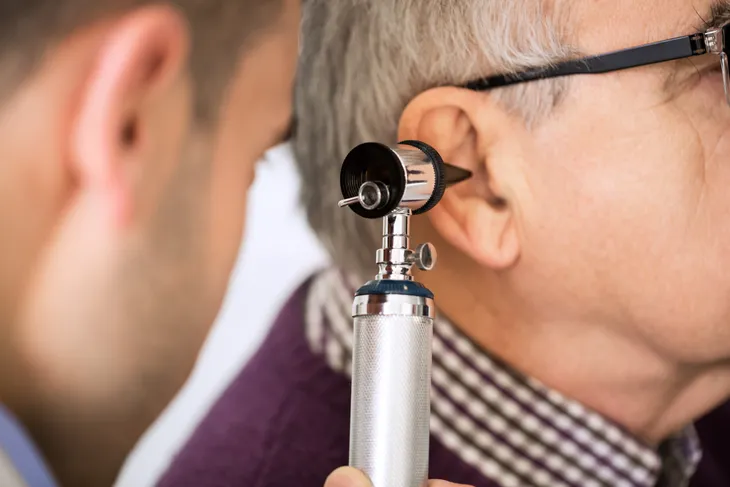- Vertigo occurs when your brain mistakenly perceives motion, and you feel like you or your surroundings are spinning.
- This sensation is usually caused by disorders within the vestibular system, which governs the body’s sense of balance.
- Episodes of vertigo vary in duration and severity, depending on the cause.
- Some attacks can last less than a minute, while others may last weeks.
Humans have a finely tuned sense of equilibrium, with the body’s vestibular system sending messages to the brain about spatial orientation and movement. When things aren’t functioning properly, however, you can experience vertigo, the false sensation of a spinning motion.
Vertigo itself isn’t a condition; it’s a symptom of a condition. This article looks at reasons you may be experiencing vertigo and ways it can be treated.
What Does Vertigo Feel Like?
Vertigo is a rotating sensation, but some people may describe it as dizziness, light-headedness, or being off balance. When you have the feeling that you’re spinning when you’re actually at rest, you have subjective vertigo. When you perceive that the surrounding environment is in motion, you’re experiencing objective vertigo.
Vertigo can occur with other symptoms such as:
- Nausea
- Vomiting
- Difficulty with balance
- Trouble walking
- Uncontrolled eye movements, known as nystagmus
Women are two to three times more likely to experience vertigo than men. Vertigo also becomes more common with age.
 Pheelings media / Shutterstock
Pheelings media / ShutterstockWhat Causes Vertigo?
Your body’s vestibular system is responsible for sensing spatial orientation, movement, and balance. Part of this system is within the inner ear, where fluids detect body position, sending signals to the central nervous system and brain so that the body can respond appropriately. Feelings of vertigo, dizziness, and motion can occur when a problem exists with the vestibular system or brain.
There are two types of vertigo. According to the National Library of Medicine, about 80-percent of vertigo relates to problems with the peripheral vestibular system, which consists of the vestibular labyrinth in the inner ear and the path leading to the brain stem. The other 20-percent of cases are caused by problems in the central vestibular system in the brainstem and brain.
 Shutterstock/didesign021
Shutterstock/didesign021Types of Peripheral Vertigo
Episodes of peripheral vertigo usually come on suddenly and can range from mild to severe, but generally, this type of vertigo can be managed or resolved.
Because peripheral vertigo is linked to the inner ear, which senses spatial orientation, you may experience other symptoms:
- Ringing in the ear or loss of hearing in one ear
- Difficulty with vision
- Problems with balance
- Onset or worsening of vertigo when you move your head
- Involuntary horizontal eye movement
Some of the most common causes of peripheral vertigo are discussed below.
Benign Paroxysmal Positional Vertigo
The predominant type of peripheral vertigo is benign paroxysmal positional vertigo (BPPV). BPPV results in short episodes of vertigo when your head moves a certain way. The trigger is different in every person and may occur when you bend toward the ground, look upward or roll in bed. This type of vertigo doesn’t result in hearing loss or ringing in the ears.
BPPV can be traced to the semicircular canals in the inner ear, which contain fluids that signal to your brain how your body is positioned. Sometimes, tiny calcium carbonate crystals, known as canaliths, can make their way into these canals, confusing the hairlike sensors in the ears. BPPV may cause unsteadiness or increase your risk of falls, but it’s not usually a serious condition.
Meniere’s Disease
Meniere’s disease is an inner ear disorder that causes peripheral vertigo. The condition occurs due to excess fluid in the ear, although the cause of the buildup isn’t known. Incidents of vertigo are sudden and may occur daily or sporadically. According to one study, vertigo from Meniere’s disease typically lasts between 20-minutes and 2-hours, with a duration of more than 6-hours being less common.
People with Meniere’s disease may also experience nausea, vomiting, diarrhea, excessive sweating, and the sensation of pressure building in the ear. Usually, only one ear is affected. Meniere’s disease can also cause progressive hearing loss or ringing in the ear, known as tinnitus, which occurs separately from vertigo.
Vestibular Neuronitis
Peripheral vertigo can also be caused by an inflammation of the vestibular nerve. This is the nerve that connects the brain to the parts of the inner ear that sense balance. Vestibular neuronitis is likely caused by a virus.
This inflammation typically results in one severe episode of vertigo that can last a week to 10-days. The spinning sensation is accompanied by nausea, vomiting, and nystagmus, but hearing isn’t affected. The initial attack may be followed by milder episodes of dizziness for a few weeks or months, but people with vestibular neuronitis usually recover fully.
Labyrinthitis
Viral infections, such as a cold, flu, or ear infection, can cause inflammation in the inner ear. This can affect the labyrinth, which includes the fluid-filled sacs that help with balance, and the cochlea, which controls hearing.
When this area becomes inflamed, you may experience vertigo, nausea, hearing loss, ringing in the ears, ear pain, and a fever. The worst of vertigo may last up to a week, but you may have lingering effects for a few months as the infection resolves itself.
Central Vertigo
Central vertigo is caused by problems in the central vestibular system, such as the brain stem or the cerebellum, which is the back part of the brain. This type of vertigo develops gradually and may be caused by conditions such as stroke, tumors, brain injury, and multiple sclerosis. Central vertigo is subjective, which means it feels like you’re spinning, not your surroundings. The episodes are usually less severe than peripheral vertigo but may persist longer rather than occur in episodes.
People experiencing central vertigo can also experience what clinicians refer to as the “Ds”:
- Double vision (diplopia)
- Difficulty swallowing (dysphagia)
- Lack of coordination (dysmetria)
- Difficulty with speech (dysarthria)
Vestibular Migraines
Approximately 40-percent of people who have migraine headaches also experience vertigo, according to the Vestibular Disorders Association. Vertigo tends to come on suddenly and may be brief or last days. This condition tends to affect women more frequently than men.
Symptoms of vestibular migraines include:
- The sensation of spinning when there’s no motion
- Severe headache on one side of the head
- Nausea and vomiting
- Sensitivity to light, sound, smell, and motion
- Difficulty balancing
- Feelings of being disoriented
Vestibular migraines can be difficult to diagnose as vertigo may not occur at the same time as a headache. Some people may experience only vertigo and not headaches.
Diagnosing Vertigo
When you see your healthcare provider, provide as much information as you can about when your symptoms began, how often it occurs, and how long the attacks last. Consider whether certain triggers bring about the sensation, and describe any other symptoms, such as problems with hearing or vision.
Your doctor may perform tests to observe when vertigo occurs. The Dix-Hallpike test, for example, is typically used to assess BPPV. It can also help doctors look for signs of nystagmus. You might also be sent for scans or referred to an ear, nose, and throat (ENT) specialist.
What to Do When Experiencing Vertigo
When you experience a vertigo attack, stay still to avoid falling and keep yourself safe. You may feel better lying down in a dark room if vertigo persists. If you experience recurring vertigo, such as with BPPV, you may need to adapt routines to reduce the likelihood of triggering an attack. Consider some of the following strategies:
- Sleep with your head raised at a 45-degree angle to prevent calcium debris from entering the semicircular canals.
- Squat when picking things up rather than bending at the waist.
- Move your head gradually, and avoid sudden movements where possible.
- Get out of bed slowly in the mornings.
Treating Vertigo
Your healthcare provider will recommend treatment based on the cause of vertigo and strategies to manage symptoms. Physicians may suggest canalith repositioning procedures, such as the Epley maneuver, which are designed to move calcium crystals out of the semicircular canals. Symptoms may improve right away but can recur and require repeated treatment.
Vestibular rehabilitation therapy is another popular option. This series of exercises expose a person to the triggers of vertigo so they can train the brain to ignore false signals.
Additional treatments include:
- Salt can cause the body to retain water. If you have fluid buildup in the ear because of Meniere’s disease, a low-salt diet may help.
- Medication can help ease nausea, vomiting, and dizziness.
- Hearing aids can help with hearing loss.













